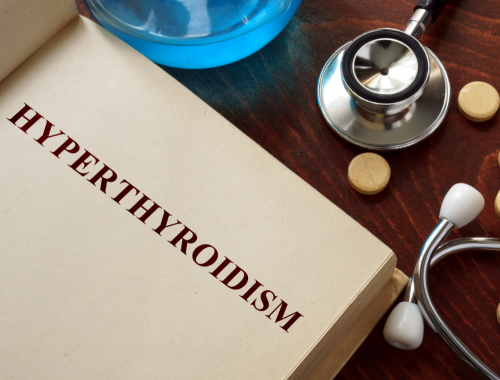Difference Between Goiter and Hyperthyroidism
Goiter is an irregular enlargement of the thyroid gland. It can be asymptomatic or can present with symptoms of hyperthyroidism or hypothyroidism. Hyperthyroidism is a condition in which excess thyroid hormone is released by the thyroid gland.

What is a goiter?
Definition:
Goiter is an irregular enlargement of the thyroid gland. It can be asymptomatic or can present with symptoms of hyperthyroidism or hypothyroidism.
Causes:
Causes of goiter include iodine deficiency, autoimmune diseases such as Grave’s disease and Hashimoto’s disease, thyroiditis, thyroid cancer, and pregnancy.
Symptoms:
Common symptoms associated with goiter include a swollen neck, difficulty breathing, hoarseness, and distended neck veins. Less commonly, the patient will have coughing, chest tightness, and dysphagia. Symptoms of hyperthyroidism such as tachycardia, sweating, weight loss, and anxiety can be seen in goiter. Also, symptoms of hypothyroidism can manifest with thyroid swelling. These include weight gain, cold clammy skin, menstrual irregularity, bradycardia, and constipation.
Diagnosis:
Diagnosis of goiter is made after blood tests, thyroid hormone level analysis, thyroid ultrasound, thyroid scan, and radiologic investigations.
Treatment:
Asymptomatic goiter does not require treatment. In case of features of hyperthyroidism, antithyroid drugs are prescribed and levothyroxine is given if features of hypothyroidism are present. Other treatment options include radioactive iodine therapy and surgery.

What is Hyperthyroidism?
Definition:
Hyperthyroidism is a condition in which excess thyroid hormone is released by the thyroid gland.
Causes:
Certain medical conditions can cause hyperthyroidism. Graves disease is an autoimmune cause of primary hyperthyroidism making up 85% of hyperthyroidism cases. Other causes of hyperthyroidism include multinodular goiter, thyroiditis which is the inflammation of the thyroid gland, and excess iodine consumption in the form of contrast dyes and medicines like amiodarone.
Symptoms:
Symptoms of hyperthyroidism include palpitations, tremors, weight loss, anxiety, diarrhea, increased sweating, menstrual irregularities, brittle hair, neck swelling, sleep disturbance, and agitation.
Diagnosis:
Diagnosis of hyperthyroidism is made after physical examination, thyroid profile results, and imaging studies like thyroid scintigraphy.
Treatment:
Treatment of hyperthyroidism involves the use of beta blockers for palpitations and tremors, antithyroid drugs like carbimazole and propylthiouracil, radioactive iodine therapy, and surgery that is a thyroidectomy.
Difference between Goiter and Hyperthyroidism
Definition:
Goiter is an irregular enlargement of the thyroid gland. It can be asymptomatic or can present with symptoms of hyperthyroidism or hypothyroidism. Hyperthyroidism is a condition in which excess thyroid hormone is released by the thyroid gland.
Causes:
Causes of goiter include iodine deficiency, autoimmune diseases such as Grave’s disease and Hashimoto’s disease, thyroiditis, thyroid cancer, and pregnancy.
Certain medical conditions can cause hyperthyroidism. Graves’ disease is an autoimmune cause of primary hyperthyroidism making up 85% of hyperthyroidism cases. Other causes of hyperthyroidism include multinodular goiter, thyroiditis which is the inflammation of the thyroid gland, and excess iodine consumption in the form of contrast dyes and medicines like amiodarone.
Symptoms:
Common symptoms associated with goiter include a swollen neck, difficulty breathing, hoarseness, and distended neck veins. Less commonly, the patient will have coughing, chest tightness, and dysphagia. Symptoms of hyperthyroidism such as tachycardia, sweating, weight loss, and anxiety can be seen in goiter. Also, symptoms of hypothyroidism can manifest with thyroid swelling. These include weight gain, cold clammy skin, menstrual irregularity, bradycardia, and constipation.
Symptoms of hyperthyroidism include palpitations, tremors, weight loss, anxiety, diarrhea, increased sweating, menstrual irregularities, brittle hair, neck swelling, sleep disturbance, and agitation.
Diagnosis:
Diagnosis of goiter is made after blood tests, thyroid hormone level analysis, thyroid ultrasound, thyroid scan, and radiologic investigations. Diagnosis of hyperthyroidism is made after physical examination, thyroid profile results, and imaging studies like thyroid scintigraphy.
Treatment:
Asymptomatic goiter does not require treatment. In case of features of hyperthyroidism, antithyroid drugs are prescribed and levothyroxine is given if features of hypothyroidism are present. Other treatment options include radioactive iodine therapy and surgery. Treatment of hyperthyroidism involves the use of beta blockers for palpitations and tremors, antithyroid drugs like carbimazole and propylthiouracil, radioactive iodine therapy, and surgery that is a thyroidectomy.
Table of differences between Goiter and Hyperthyroidism

FAQs
Are goiter and hyperthyroidism the same?
No, a goiter may present with either hyperthyroidism, hypothyroidism, or can be euthyroid.
Does a goiter mean hyperthyroidism?
No, not always.
Can you have a goiter without hyperthyroidism?
Yes, it can be due to hypothyroidism or even normal thyroid function tests.
What is the difference between a goiter and a thyroid problem?
Goiter is an enlargement of the thyroid gland whereas thyroid problem is due to abnormal thyroid function tests.
Does all hyperthyroidisms have goiter?
No.
Should a goiter be removed?
If it is causing obstructive symptoms such as dyspnea, and dysphagia and is big then it should be removed.
- Differences Between Reptiles and Amphibians - May 17, 2024
- Difference Between Ophthalmology and Optometry - May 15, 2024
- Difference Between Fear and Anxiety - April 2, 2024
Search DifferenceBetween.net :
Leave a Response
References :
[0]Knudsen, Nils, et al. "Risk factors for goiter and thyroid nodules." Thyroid 12.10 (2002): 879-888.
[1]Hurley, Daniel L., and Hossein Gharib. "Evaluation and management of multinodular goiter." Otolaryngologic Clinics of North America 29.4 (1996): 527-540.
[2]Franklyn, Jayne A. "The management of hyperthyroidism." New England Journal of Medicine 330.24 (1994): 1731-1738.
[3]Image credit: https://www.canva.com/photos/MADA-X1xaKY-goiter-written-on-book-with-tablets-/
[4]Image credit: https://www.canva.com/photos/MADA9dicLWA-hyperthyroidism-written-on-book-with-tablets-medicine-concept-/
